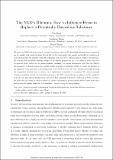| dc.contributor.author | Kraft, Tim | |
| dc.contributor.author | Erhun, Feryal | |
| dc.contributor.author | Zheng, Yanchong Karen | |
| dc.date.accessioned | 2014-06-30T13:48:23Z | |
| dc.date.available | 2014-06-30T13:48:23Z | |
| dc.date.issued | 2013-10 | |
| dc.date.submitted | 2011-09 | |
| dc.identifier.issn | 1523-4614 | |
| dc.identifier.issn | 1526-5498 | |
| dc.identifier.uri | http://hdl.handle.net/1721.1/88121 | |
| dc.description.abstract | We study a nongovernmental organization's (NGO's) decisions when it attempts to remove a potentially hazardous substance from commercial use in a market with competing firms. Specifically, we determine under what market and regulatory conditions an NGO should target the industry versus the regulatory body to influence firms to replace the substance. We examine how the NGO's strategy changes as the NGO's pragmatism (i.e., the extent to which the NGO incorporates firms' profits into its decision making) increases. Our results demonstrate that when the NGO is less pragmatic, it should examine the existing market structure to determine whether to target the industry or the regulatory body. However, as the pragmatism of the NGO increases, the NGO should increasingly leverage the competition between firms to ensure that a replacement is available to consumers. We examine multiple extensions including varying the competition dynamics, the NGO targeting both the industry and the regulatory body, the time discounting of replacement costs, and a firm potentially lobbying to counteract an NGO's activism. We show that the potential for a firm to lobby can benefit consumers by motivating the NGO to exert more effort and increase the market sensitivity to a substance, thereby forcing the firm to replace. | en_US |
| dc.description.sponsorship | National Science Foundation (U.S.) (Grant NSF/CAREER-0547021) | en_US |
| dc.language.iso | en_US | |
| dc.publisher | Institute for Operations Research and the Management Sciences (INFORMS) | en_US |
| dc.relation.isversionof | http://dx.doi.org/10.1287/msom.2013.0440 | en_US |
| dc.rights | Creative Commons Attribution-Noncommercial-Share Alike | en_US |
| dc.rights.uri | http://creativecommons.org/licenses/by-nc-sa/4.0/ | en_US |
| dc.source | SSRN | en_US |
| dc.title | The NGO's Dilemma: How to Influence Firms to Replace a Potentially Hazardous Substance | en_US |
| dc.type | Article | en_US |
| dc.identifier.citation | Kraft, Tim, Yanchong Zheng, and Feryal Erhun. “The NGO’s Dilemma: How to Influence Firms to Replace a Potentially Hazardous Substance.” M&SOM 15, no. 4 (October 2013): 649–669. | en_US |
| dc.contributor.department | Sloan School of Management | en_US |
| dc.contributor.mitauthor | Zheng, Yanchong Karen | en_US |
| dc.relation.journal | Manufacturing & Service Operations Management | en_US |
| dc.eprint.version | Author's final manuscript | en_US |
| dc.type.uri | http://purl.org/eprint/type/JournalArticle | en_US |
| eprint.status | http://purl.org/eprint/status/PeerReviewed | en_US |
| dspace.orderedauthors | Kraft, Tim; Zheng, Yanchong; Erhun, Feryal | en_US |
| dc.identifier.orcid | https://orcid.org/0000-0002-6991-0649 | |
| mit.license | OPEN_ACCESS_POLICY | en_US |
| mit.metadata.status | Complete | |
